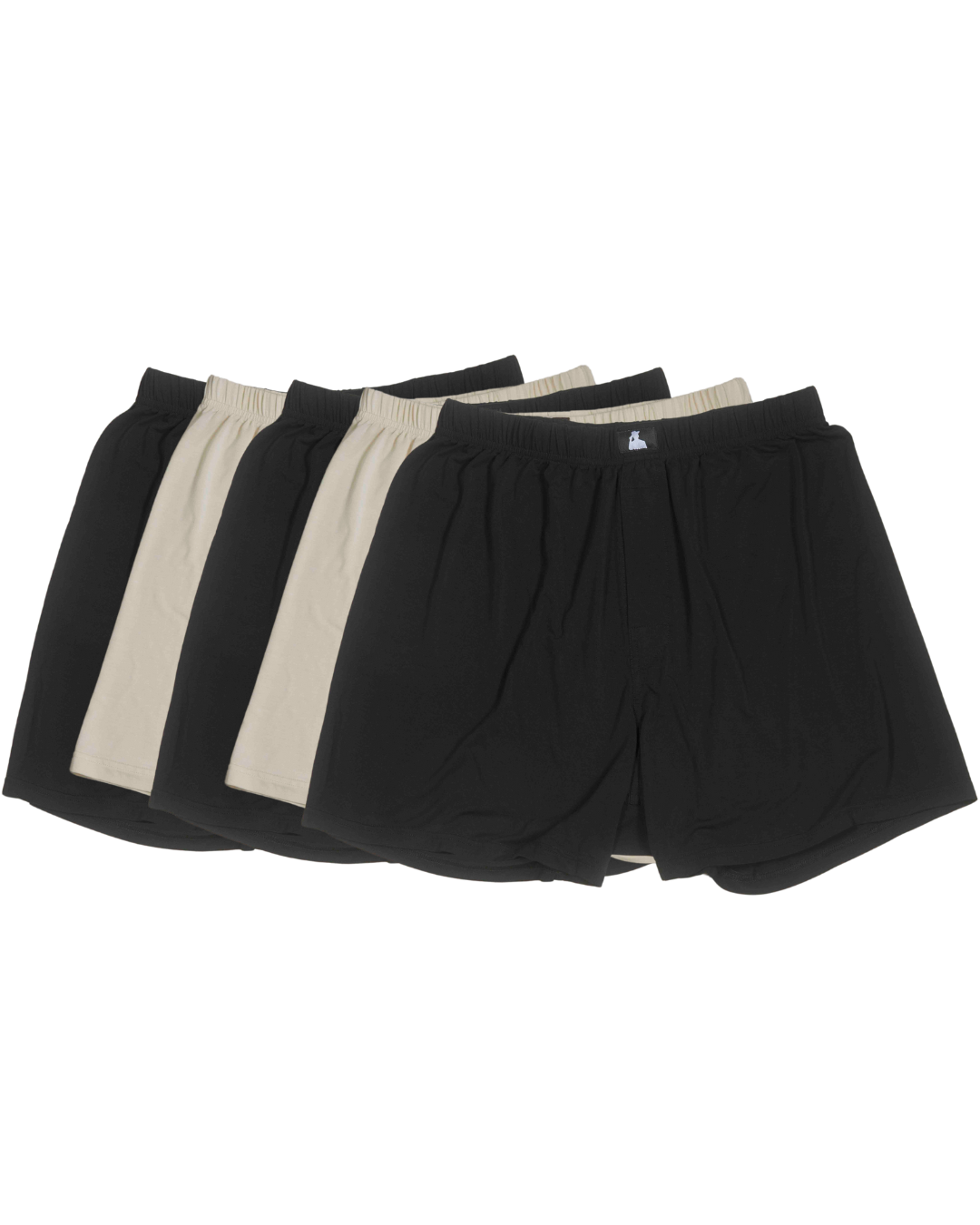The Best Underwear for Sperm Health: What to Wear (and What to Avoid)
Written By The Mr. Fertyl Research & Education Team
Many men are learning that underwear choice is more than just a comfort decision – it can influence fertility. Sperm production works best at a temperature a few degrees cooler than core body heat, so the fabrics and fit around the testicles matter. In fact, researchers note that sperm counts vary with many factors (age, lifestyle, even the type of underwear worn) [1]. Some large reviews have even found a significant global drop in sperm counts since the 1970s [1], although causes are complex. To support your reproductive health (and the planet’s!), it helps to know what fabrics and fits to choose – and which ones to avoid.
Why Underwear Matters for Fertility
Sperm health depends on three main things: quantity, movement (motility), and shape (morphology) [4]. The testicles normally hang outside the body so they stay a few degrees cooler than core temperature. Studies show that raising scrotal temperature even slightly can dramatically impair sperm production [10]. For example, experimental heating (like 30 minutes of microwave-like radiation on the testes) caused severe drops in sperm output [10]. Even common habits matter: men who spent a few hours in a sauna twice a week saw sperm counts drop by up to 50% [10]. One study found that infertile men had scrotal temperatures about 0.4–0.5°C higher than fertile men [10]. All of this underscores that keeping the genital area cool and unstressed can help maintain sperm count, motility and morphology.
Importantly, experts advise comfort and coolness. Mayo Clinic explains that “if the scrotum gets too warm, it could lower the body’s ability to make sperm effectively,” and recommends loose-fitting underwear and avoiding extra heat (like long sits in hot tubs or saunas) to improve sperm quality [4]. Similarly, Cleveland Clinic notes that although briefs do hold testes closer to the body, the evidence actually shows little real effect on fertility – so men should wear what feels comfortable [3]. In practice, that means favoring breathable, loose styles over tight, heat-trapping garments.
Heat and Tight Fit: Steer Clear
Because sperm need a cooler environment, tight or constricting underwear can raise risks. Men often wonder if wearing briefs or compression shorts will hurt fertility. While some studies show briefs slightly raise temperature, there is no proof this alone causes infertility [2]. Yet most fertility specialists play it safe: they encourage boxers or loose boxer-briefs rather than skin-tight briefs. As Mayo’s experts put it, avoid unnecessary heat: “no research says that [briefs] affects fertility,” but hot tubs and saunas definitely do (they can depress sperm counts for about three months, the life cycle of sperm) [2]. Indeed, one university urologist points out that laptop use and sedentary sitting can warm the testes by a couple of degrees, whereas simple changes (using a desk or choosing airy clothes) can help offset that heat [4][10].
In short, anything that elevates scrotal temperature even modestly – tight elastic, insulation from hot pants, or direct heat – can inhibit spermatogenesis. Keeping the area cooler, drier and more ventilated is the safer choice. Mayo Clinic specifically recommends loose-fitting cotton or bamboo underwear and avoiding heat stress to “improve sperm quality” [4].

Support Your Sperm Health, Right From the First Layer.
Shop Fertility-Safe UnderwearBeware of Chemical Exposures
Underwear fabrics can carry hidden chemical risks. Many textiles contain endocrine-disrupting chemicals (EDCs) that can mimic hormones. A 2018 review warns that EDCs are present in everyday products – including plastic components and even clothes – and that long-term exposure can lead to declines in semen quality [5]. For example, plasticizers like phthalates and bisphenol A (BPA), often found in polyester, nylon and fabric finishes, can leach out during wear or laundry. In fact, researchers recently discovered microplastic fibers inside human testicles [7], and in dogs those fibers correlated with lower sperm counts. While the science is still emerging, it’s enough to urge caution.
Synthetic fabrics shed tiny plastic microfibers every time they’re worn or washed. A PBS NewsHour report explains that synthetic textiles are the largest source of microplastics in the environment [8]. A single laundry load can release millions of microscopic fibers into water. These fibers often contain added chemicals (phthalates, BPA and other plasticizers) that can leach and disrupt endocrine function [8]. In simpler terms: a polyester or nylon blend not only holds heat, it may also carry hormone-acting chemicals close to the skin.
Given all this, it’s wise to minimize skin contact with synthetic, untested fabrics. Be especially cautious of non-breathable blends or microfiber underwear with no safety testing. If you want peace of mind, look for clothes tested to exclude harmful substances. For example, the OEKO-TEX® Standard 100 label guarantees every thread and trim has been screened for 1,000+ toxic chemicals [9]. Garments with this certification are deemed “harmless to human health” by the Oeko-Tex Institute [9]. Choosing OEKO-TEX certified underwear means you won’t unknowingly expose your skin (or fertility) to formaldehyde, pesticides, phthalates or heavy metals that sometimes hide in fabrics.
What to Avoid, What to Look For
Here are some practical guidelines for fertility-friendly underwear and habits:
- Skip tight, heat-trapping undergarments: Avoid very snug briefs or athletic compression shorts that press the testes against the body. Opt for looser styles (boxers or relaxed boxer briefs) that allow air circulation [4].
- Avoid synthetic, non-breathable fabrics: Materials like polyester and nylon blends tend to retain heat and can include chemical finishes. They also shed microfibers with hormone disruptors [8]. Instead, favor natural, moisture-wicking fabrics such as Bamboo Lyocell or cotton.
- Check for eco-safety labels: Choose underwear with OEKO-TEX Standard 100 (or similar) certification [9]. This ensures the garment has passed strict tests against irritants, heavy metals, formaldehyde, and pesticide residues. Even better, look for brands that emphasize chemical-free processing and natural dyes.
- Watch your habits around heat: Men concerned about fertility should limit hot baths, saunas and prolonged laptop-on-lap sessions [4][10]. If you sit for long periods (commuting, desk work), take breaks or use cooling techniques to avoid trapping heat.
- Choose fertility-conscious designs: For example, underwear with a breathable pouch or contoured space for the genitals can help keep things cooler. Also note how elastane (stretch fiber) is used: the best styles put stretch in waistbands or side panels – not touching the skin – so your genitals contact only the soft main fabric.
By following these tips, you’ll minimize heat and chemical exposures. Remember that sperm development takes weeks, so consistent comfort and coolness can help over time.

Healthier Underwear Starts Here.
Feel The DifferenceWhy Bamboo Lyocell Are a Smart Pick
Natural fibers like cotton and bamboo tend to breathe far better than synthetics. Bamboo Lyocell in particular is prized for its silky softness, high absorbency and temperature regulation. It feels cool against skin and wicks moisture, which helps prevent sweating and chafing. Many users find bamboo undergarments very comfortable on sensitive skin. Bamboo also grows quickly with little water, making it an eco-friendly choice.
A number of brands have begun making “fertility-friendly” underwear using Bamboo Lyocell and other natural fabrics. One example is Mr. Fertyl, which offers OEKO-TEX® certified Bamboo Lyocell underwear designed specifically for men’s health. Their underwear combine the benefits of bamboo (breathability, softness and antibacterial properties) with a careful construction that avoids potentially problematic touches. The elastane (stretch) in Mr. Fertyl’s design is placed in the waistband and outer layers, not directly against the genital skin. This means your body only contacts the pure bamboo fabric. The result is underwear that stays airy and dry, without irritating or warming the testicles.
Moreover, Bamboo Lyocell naturally resists odor-causing bacteria, so it keeps things fresher – another plus for men concerned about hygiene and comfort. And because every Mr. Fertyl garment carries the OEKO-TEX® Standard 100 label, you know it was lab-tested for toxins [9]. In effect, choosing this kind of eco-safe underwear checks all the boxes: it promotes cooler scrotal temperature, avoids unwanted chemicals, and is made of renewable material.
Finally, remember that underwear is just one piece of the fertility puzzle. Healthy sperm also depends on diet, exercise, avoiding smoking, and regular medical care [4]. But since fertility issues are surprisingly common (nearly half of all couples trying to conceive encounter male-factor infertility), there’s no shame in optimizing every manageable factor – underwear included.
In summary, if you’re trying for a baby or just want to boost your reproductive health, keep your boys cool and chemical-free. Go for well-fitting boxer or boxer-brief styles in natural, breathable fabrics. Look for OEKO-TEX® certification to avoid hidden toxins [9]. And consider specialized options like Bamboo Lyocell underwear from Mr. Fertyl, which offer both comfort and the peace of mind that comes with eco-friendly, fertility-focused design. With these simple clothing changes, you can support sperm count, motility and morphology – and feel good about wearing something that’s healthy for you and for the environment [4][5].
- Szalinski, C. (2023). Are Sperm Counts Really Declining? – Scientific American. Source.
- Ogle, A. (2019). Boxers or briefs? 4 common fertility myths debunked – Mayo Clinic Health System. Source.
- Vij, S. (2019). Are You Unknowingly Lowering Your Sperm Count? When to Worry – Cleveland Clinic. Source.
- Mayo Clinic (2025). Healthy sperm: Improving your fertility – Mayo Clinic. Source.
- Ahmad, G. (2018). Endocrine disrupting chemicals and impact on male reproductive health – Translational Andrology and Urology. Source.
- D’Angelo, S. and Meccariello, R. (2021). Microplastics: A Threat for Male Fertility – Environmental Advances. Source.
- Carrington, D. (2024). Microplastics found in every human testicle in study – The Guardian. Source.
- Weis, J. (2024). Laundry is a top source of microplastic pollution – PBS NewsHour. Source.
- OEKO-TEX® (n.d.). OEKO-TEX® STANDARD 100: The Original Safety Standard. Source.
- McVean, A. (2020). Facts And Myths Of Male Fertility: Tight Underwear, Hot Tubs, Marijuana, And More – Skeptical Inquirer (McGill OSS). Source.

